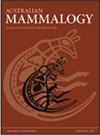当祖先出没时——与祖先的进化联系会影响澳大利亚猎物对引入的捕食者的脆弱性吗?初步研究
IF 1.2
4区 生物学
Q3 ZOOLOGY
引用次数: 1
摘要
澳大利亚有袋动物的高灭绝风险被归因于它们未能识别新的捕食者,应用了不适当的反捕食者反应,以及新捕食者的先进狩猎策略。这项研究是探索Lumholtz树袋鼠(Dendrolagus lumholtzi)(a)是否能够识别来自不同捕食者的气味线索作为威胁,以及(b)是否具有捕食者原型特异性的反捕食者反应的初步尝试。少数可用的圈养树袋鼠暴露在两种不同原型的现存捕食者(蟒蛇、野狗)的粪便气味中,这是一种区域性灭绝的捕食者,与过去的陆地捕食者(塔斯马尼亚魔鬼)和一种新型捕食者(家犬)非常相似。薰衣草油被用作非捕食者的新气味,水被用作对照。结果表明,所有受试者都将所呈现的气味与威胁联系起来,尽管程度不同,但没有表现出捕食者原型特有的反应。当遇到捕食者,包括新的捕食者时,这个物种似乎在地面上应用了祖先的反捕食者反应。尽管这一结果需要在更多的动物身上得到证实,但对澳大利亚猎物对新型捕食者的脆弱性的进一步研究应该考虑到澳大利亚猎物物种的祖先历史。本文章由计算机程序翻译,如有差异,请以英文原文为准。
When ancestry haunts – can evolutionary links to ancestors affect vulnerability of Australian prey to introduced predators? A preliminary study
The high extinction risk of Australian marsupials has been attributed to their failure to recognise novel predators, the application of inappropriate antipredator responses, and advanced hunting strategies of novel predators. This study is a preliminary attempt to explore whether the Lumholtz’ tree-kangaroo (Dendrolagus lumholtzi) (a) is able to recognise odour cues from different predators as threats, and (b) possesses predator-archetype specific antipredator responses. A small number of available captive tree-kangaroos were exposed to faecal odours from two extant predators of different archetypes (python, dingo), a regionally extinct predator which closely matches past terrestrial predators (Tasmanian devil), and a novel predator (domestic dog). Lavender oil was used as non-predator novel odour and water as control. Results suggest that all subjects associated the presented odours with a threat, albeit to different degrees, but did not display predator-archetype specific responses. It appears that this species applies an ancestral antipredator response of flight-on-the ground when encountering predators, including novel predators. Although the results need to be confirmed with more animals, further studies on the vulnerability of Australian prey to novel predators should take the ancestral history of Australian prey species into account.
求助全文
通过发布文献求助,成功后即可免费获取论文全文。
去求助
来源期刊

Australian Mammalogy
ZOOLOGY-
CiteScore
2.50
自引率
8.30%
发文量
26
期刊介绍:
Australian Mammalogy is a major journal for the publication of research in all branches of mammalogy. The journal’s emphasis is on studies relating to Australasian mammals, both native and introduced, and includes marine mammals in the Antarctic region. Subject areas include, but are not limited to: anatomy, behaviour, developmental biology, ecology, evolution, genetics, molecular biology, parasites and diseases of mammals, physiology, reproductive biology, systematics and taxonomy.
Australian Mammalogy is for professional mammalogists, research scientists, resource managers, consulting ecologists, students and amateurs interested in any aspects of the biology and management of mammals.
Australian Mammalogy began publication in 1972 and is published on behalf of the Australian Mammal Society.
 求助内容:
求助内容: 应助结果提醒方式:
应助结果提醒方式:


